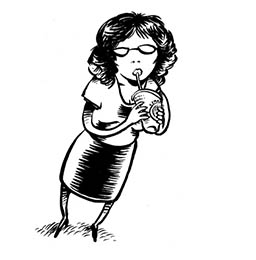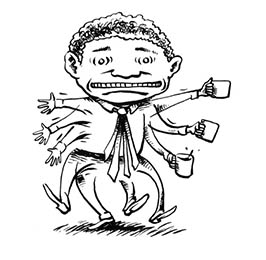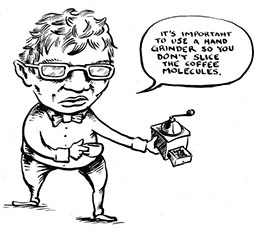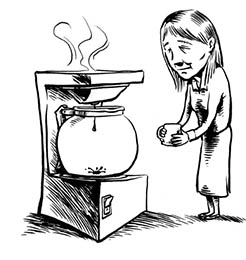Modern Office Coffee Culture
- By Miriam Wolf
- Reading Time: 7 mins.
Oh coffee, is there anything you can’t do? You taste great. You enhance our productivity at work. And you may even be a veritable health-giving elixir that could stave off Alzheimer’s and reduce the risk of developing cancer and diabetes.

She likes coffee, but only if it’s dressed up in plenty of steamed milk, flavored syrups, and whipped cream. Prefers to take 90 percent of her calories per day courtesy of her extra-large salted caramel mochas. Illustration by Shannon Wheeler.
For most of us, coffee is an integral part of our work lives. From the factory workers who get their joe from a machine in the break room to the tech company employees enjoying onsite coffee tastings, we can’t get our day started properly without it. So it is great news that research now shows coffee may have significant health benefits, debunking long-held assumptions that it is an unhealthy choice.
Recent studies have indicated drinking more than two cups of coffee per day decreased the risk of developing Type 2 diabetes, and that drinking coffee is also associated with a lower risk of Parkinson’s disease as well as dementia and Alzheimer’s disease.
Even the old adage to avoid coffee if you have high blood pressure is being reevaluated. Yes, caffeine can cause your blood pressure to rise dramatically, but, according to a 2011 meta-study in the American Journal of Clinical Nutrition, there is “no association between longer-term coffee consumption and increased blood pressure or between habitual coffee consumption and an increased risk of cardiovascular disease in hypertensive subjects.”
The key to coffee’s health-promoting properties might be in its high level of antioxidant compounds — and that we drink so much of it. According to a 2004 Norwegian study in The American Society for Nutritional Sciences, coffee was the single greatest contributor to total antioxidant intake, surpassing fruits and vegetables. Antioxidants are powerful cancer fighters, and coffee is one of the world’s most popular drinks.
Want farm-fresh fruit?
We've got you covered.
You will never spot him without a full mug of pitch-black joe. Hydrates exclusively with coffee. Often extremely voluble in meetings, but has no memory later of what he has proposed or agreed to. Illustration by Shannon Wheeler.
Still, there are some caveats. Certain populations should avoid coffee, such as pregnant women, children, and teens. According to a study on coffee and health by the Harvard School of Public Health, pregnant women are advised to limit their coffee to not more than one cup per day. Recent research has also pointed to young people’s increasing intake of caffeine through coffee and energy drinks, and since the effects are poorly studied, it’s probably a good idea for kids and teens to limit their intake as well.
In addition, because unfiltered coffee contains substances that can raise LDL (“bad”) cholesterol, using a paper filter to prepare your coffee is a smart idea. And finally, most of the research shows benefits up to around four to six eight-ounce cups of coffee per day. Additives such as syrups, sugar, cream, and artificial whiteners all add calories to your beverage.
Coffee in the Modern Workplace
Workplace coffee has come a long way since the age of the giant percolating urn of burnt-tasting vileness that masqueraded as coffee. Many employers continue to provide some kind of coffee supply, realizing that caffeinated employees are happier and more productive employees.

Wouldn’t be caught dead drinking the office “swill.” Buys locally roasted beans (and has experimented with roasting his own), driving the other people in his area crazy by grinding them in his cubicle several times per day. Took a 10-hour class on the perfect pour-over.Illustration by Shannon Wheeler.
Large companies treat coffee as a vital employee perk. At the larger campuses of chip giant Intel, my coffee source reports that employees have access to four types of coffee from two different vendors, some flavored, some decaf. Concerned about paper-cup waste, Intel provides employees with an insulated coffee cup for their use on-site.
But this type of vendor-provided coffee may be on the wane. Single-pod brewing machines are increasingly popular, giving everyone individual control over their coffee, hot chocolate, or tea choices, but raising concerns for increased waste. (Each beverage “pod” leaves behind a plastic and foil container.)
Get tips for your office
Be an office hero!
And many of us aren’t even drinking the office coffee, no matter how fancy it is. According to Accounting Principals’ 2013 “Workonomix Survey,” which looked at the spending habits of American workers, more than 80 percent of us buy coffee regularly, spending about $21 per week on it.
If you’re running out to the local coffee shop or corner Starbucks several times a day, you’re not at your desk. But at Nike headquarters in Oregon, employees don’t have to go to the Starbucks, the Starbucks has come to them. My Nike insider Jonanna tells me there’s a Starbucks kiosk in their building, too. “It’s about, oh, a 20-second walk away from my desk. That’s where most people get their coffee. It’s kind of a thing there. Like, there are all these couches and stuff and people often grab a coffee and have their meetings out there by the Starbucks.” But Starbucks kiosks at Nike and other big companies don’t give away free coffee, it’s subsidized by the employer so it’s cheaper than a regular Starbucks; employees still have to pay.

Usually found standing in front of the coffee maker first thing in the morning, her bleary eyes fixed on the coffeemaker as it brews. Most likely to use the “drip stop” feature to sneak a cup out before the machine has finished its brewing cycle. WARNING: Although Morning Glory is sweet and even-tempered, it is extremely dangerous to interact with her before her first cup in the morning. Illustration by Shannon Wheeler.
Some workplaces are still kickin’ it old-school. At a large Michigan-based manufacturer, my coffee spy Jake noted that there are coffee machines for every department, from sales to fabrication. Workers chip in and buy big bags of coffee from Costco. In each department, there’s usually one person who takes on the responsibility for the coffee-making. “In my department, I’m that guy. I make it in the morning and a couple of times during the day.” Do people from other departments come to sample his brew? “Oh, yeah,” Jake says. He also wanted it known that in his neck of the woods, they don’t put anything “foofy” in their coffee—like milk. Most just drink it black.
At The FruitGuys world headquarters in South San Francisco, the office kitchen has a coffee machine that is fed regularly. Scott Larson of the SSF office details: “While we do get free organic, local coffee in the office from Jeremiah’s Pick, I’ve created a sub-culture within the IT Department by bringing in freshly roasted Philz coffee beans and doing individual pour-overs. Philz Coffee is as close to coffee perfection as I’ve ever tasted, and it is 100% essential to have good coffee in the workplace or nothing will ever get done.”
Get tips for your office
Be an office hero!
And here in Portland in my day job’s small office setting, only a few of us drink the office coffee. Because I hate the taste of coffee that’s been sitting on a warmer all day, I invested in a new brewer with a thermal carafe. We take turns bringing in coffee and half-and-half. The first one there in the morning (usually me), brews a pot. Easy-peasy.
Easy Steps to Office Coffee Harmony
If your office has no coffee vendor service, in-house baristas, or brew pods, you might want to consider following these rules for optimal workplace coffee harmony:
- If you take the last cup of coffee, and it’s not near quittin’ time, make a new pot.
- When you brew a pot, hew as closely as possible to the recommended standard measurements for good coffee (2 tablespoons of ground coffee for every 6 ounces of water).
- Does the burner have spilled coffee on it? Are there coffee grounds on the counter? Wipe it up. Nothing ruins the aroma of freshly brewed coffee faster than the smell of burned coffee.
- It’s a nice touch to put a post-it note on the machine with the time the coffee was brewed.
- If you take the last cup of coffee, and it’s not near quittin’ time, make a new pot. (Oh, I said that already? Well, it’s IMPORTANT.)
Get tips for your office
Be an office hero!
Illustrations by Shannon Wheeler
Miriam Wolf is a Portland-based wellness coach and writer, and is the editor of The FruitGuys Almanac newsletter.
Shannon Wheeler is a cartoonist best known for Too Much Coffee Man but he’s also cartooned for The New Yorker and The Onion. His current books are a short version of the bible called God Is Disappointed in You and a collection of gag cartoons called I Don’t Get It.


